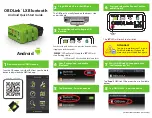
Maintenance—Operation Checkout
OUO1065,0000F89 -19-24APR12-1/1
OUO1065,0000DCB -19-04FEB12-1/24
OUO1065,0000DCB -19-04FEB12-2/24
OUO1065,0000DCB -19-04FEB12-3/24
OUO1065,0000DCB -19-04FEB12-4/24
Continued on next page
OUO1065,0000DCB -19-04FEB12-5/24
Fault Finding
General
With any fault finding, the first step is to decide where
to investigate. Sometimes this is obvious, but on other
occasions a little detective work will be necessary. The
maintenance operator who makes half a dozen haphazard
adjustments or replacements may be successful in curing
a fault (or its symptoms), but will be none the wiser if the
fault occurs again and may well have spent more time and
money than was necessary.
A calm and logical approach will be more satisfactory in
the long run.
Always take into account any warning signs or
abnormalities that may have been noticed in the period
preceding the fault, i.e. power loss, high or low gauge
readings, unusual noises, and remember that failure of a
component such as a circuit breaker of shaft seal may
only be a pointer to some underlying fault. Whatever the
fault, certain basic principles apply. These are as follows:
1.
Verify the fault.
This is simply a matter of being sure you know what the
symptoms are before starting work. This is particularly
important if you are investigating a fault for someone
else who may not have described it very accurately.
2.
Don't overlook the obvious.
For example, if a function will not operate, is it the
solenoid, wiring, or no hydraulic pressure? If an
electrical fault is indicated, check the diagnostic
indicators before digging into the wiring.
3.
Cure the disease, not the symptom.
Replacing a shaft seal may stop the immediate leak,
but the cause may be too much back pressure.
4.
Do not take anything for granted.
Be aware a (new) component may itself be defective
(especially if its been rattling around in the tool box
for months), and do not leave components out of a
fault diagnosis sequence just because they are new or
recently fitted. When you do finally diagnose a difficult
fault, you will probably realize that all the evidence
was there from the start.
Operational Checks
•
1
Super Cut 100—Operational Checks
Saw Bar Wears
Abnormally or Top
Roller Failure
Chain tension pressure is too high.
YES:
Adjust tension
pressure.
NO:
See your authorized
dealer for repair.
Chain lubrication Check
Chain lubrication malfunction.
YES:
Check lubrication
system.
NO:
See your authorized
dealer for repair.
Tensioner Check
Air in tensioner system.
YES:
Bleed tensioner
system.
NO:
See your authorized
dealer for repair.
3-4-1
053122
PN=76
















































